什么是云计算?定义、类型和好处
租用 IT 服务通常比现场数据中心的 DIY 方法更具商业意义。花费时间和金钱来创收总是比承担本地服务器机房的负担(和费用)更好的选择。
云计算是这种思维方式背后的首选技术。使用云使公司能够依赖现成的 IT 资源,这一战略提供了一系列独特的业务优势。
本文是云计算的完整指南 这解释了您需要了解的有关这项技术及其在现代 IT 中的作用的所有信息。阅读这篇文章后,您将能够就云是否适合您的业务需求做出明智的决定。
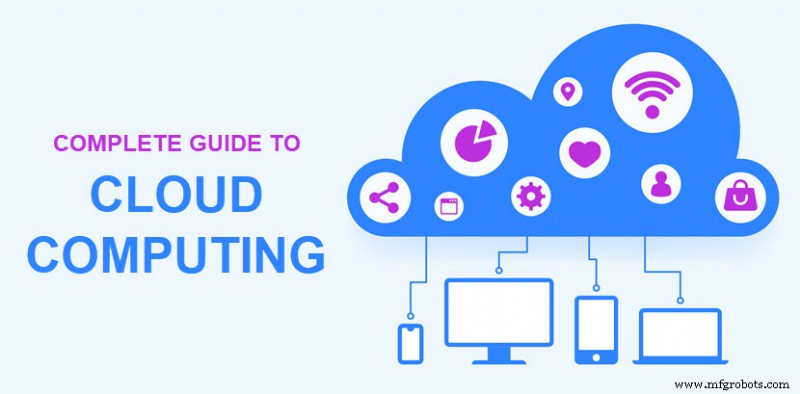
什么是云计算?
云计算是消费者通过 Internet 使用的任何 IT 资源(服务器、数据库、网络等)的总称。最终用户外包现成的资源并在线访问它们,而不是依赖本地基础设施。云的其他(远不那么流行的)名称是效用计算 和按需计算 .
公司决定使用云服务的原因有很多:
- 依靠云无需设置和维护昂贵的现场数据中心。
- 云资源使企业能够快速、廉价地构建完全符合其要求的自定义 IT 环境。
- 只要有互联网连接,您就可以在任何地方使用任何设备访问基于云的数据。
- 云提供的性能和高可用性水平对于大多数公司来说是不现实的。
- 云资源可随 IT 需求扩展。您可以在必要时立即添加更多计算资源。反过来也是如此:一旦需求恢复正常,您就可以缩减产能并确保没有不必要的支出。
- 由于主要供应商始终处于最新行业标准的最前沿,因此使用云可以持续访问尖端技术。
我们大多数人每天都在使用云计算。当您在 Google 中输入查询时,您桌上的计算机并不是找到答案的设备。该请求通过 Internet 传输到 Google 的数千个集群服务器之一,这些服务器挖掘结果并将其发送回您的设备。
同样的原则适用于任何在线服务(发送电子邮件、编辑在线文件、流式传输电影、听音乐、查看社交媒体图片等)。
云计算简史
虽然对公众来说是一个相对较新的概念,但云并不是什么新鲜事。以下是云计算如何发展成为我们今天所熟知的技术的简要概要:
- 在 1950 年代初期,组织开始使用计算机,但发现为每个部门购买一台设备过于昂贵。在 1950 年代末和 1960 年代初,公司开始使用大型主机计算机和一种称为分时的过程 .
- 分时可以更有效地利用处理器时间。用户将同时访问计算大型机的实例,从而最大限度地提高处理能力。分时背后的理念是现代云计算的基础。
- 1969 年,J.C.R. Licklider 将按需计算的概念推向了新的高度。 Licklider 创建了高级研究计划署网络 ,互联网的前身,它连接了美国各地的计算机,使用户能够从远程位置访问数据。
- 1970 年代的第一台虚拟机 (VM) 是又一大步。虚拟机使我们能够在单个物理设备中运行多个系统,这一概念对云计算的进步产生了巨大影响。
- 在 1980 年代,谷歌、亚马逊和微软进一步推进了在线服务。
- 到 1990 年代末和 2000 年代初,行业巨头开始通过 Internet 提供服务(主要是可下载软件和在线文件存储)。
- 1999 年,Salesforce 成为第一家从网站交付商业应用程序的公司。
- 2006 年,亚马逊推出了 AWS,这是我们今天拥有的第一个云服务。紧随其后,其他主要科技公司也通过自己的云产品进入市场。
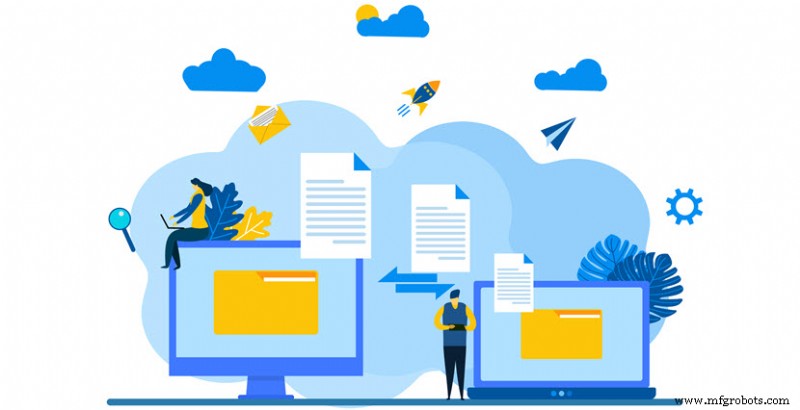
云计算是如何工作的?
从消费者的角度来看,云的工作方式很简单。只要有可用的 Internet 连接,最终用户就可以访问基于云的文件。
从云提供商的角度来看,操作更加复杂。云计算基础架构有两个主要组成部分:
- 前端 使最终用户能够访问和管理基于云的数据。该组件包括消费者可见的所有元素,例如浏览器、Web 应用程序的 GUI 等。
- 后端 负责安全地存储和共享数据。此部分包括提供商托管数据所需的所有设备(存储、专用服务器、操作系统、网络、安全协议等)。
后端运行在能够处理成百上千用户的大型数据中心的计算机上。中央服务器管理前端和后端之间的通信。此服务器:
- 使用中间件管理客户端设备和云服务器之间的链接。
- 使用互联网与消费者共享数据(除非设计有专用网络)。连接必须具有高带宽、几乎没有延迟以及顶级网络安全性。
- 依靠严格的云安全协议来促进数据的安全交换。
云在很大程度上依赖于虚拟化和自动化:
- 服务器虚拟化使系统能够抽象和提供现成的 IT 服务。
- 自动化为用户提供了高度的自助服务来配置资源、连接服务和部署云工作负载。
云计算的特点
以下是云计算最显着的特点:
- 按需自助配置: 消费者在决定需要进行更改时启动资源,并且云会在几分钟内自动更新。当客户想要调整系统时,无需联系提供商。
- 托管服务: 除非您运行内部私有云,否则使用云资源是一种托管 IT 服务。消费者不必担心维护硬件、更新软件或管理交付网络。
- 现收现付模式: 企业通常以现收现付的方式购买云服务,类似于您支付电费的方式。您可以根据需要购买尽可能多(或尽可能少)的服务。
- 终极可扩展性(上下): 消费者可以随着需求的增加而扩大资源规模,并随着需求的减少而缩小资源规模。添加和删除资源不需要重新启动服务器,因此更新基础架构不会导致停机。
- 远程访问: 用户可以从任何有互联网连接的地方访问他们基于云的数据。
- 多租户: 每种类型的云都允许多个租户共享相同的物理基础设施。根据设置,云对公众开放或仅限于满足特定条件的用户(例如,特定公司的员工)。
- 转为运营费用: 在云中工作意味着 IT 成本不再属于资本支出。在我们的资本支出与运营支出文章中了解为什么这会让您感到兴奋。
- 工作负载弹性: 在云环境中创建冗余资源既快速又简单,因此很容易防止数据丢失。系统还可以快速从中断中恢复(例如,尝试数据泄露或有人试图注入勒索软件)。
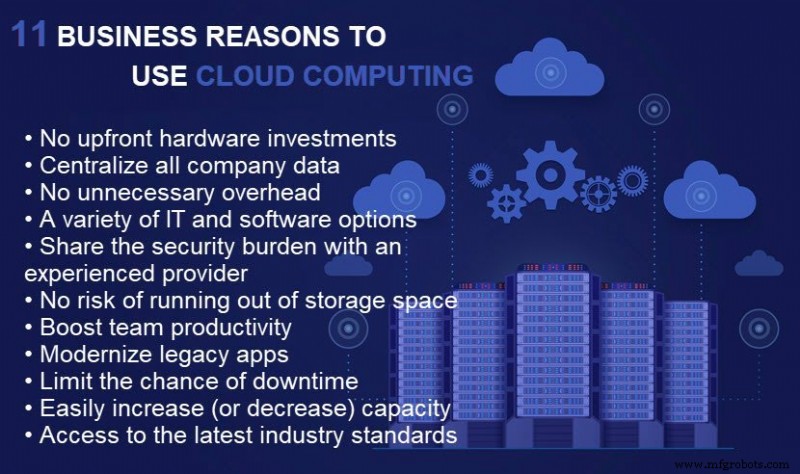
云计算的类型
在部署和服务模型方面存在不同类型的云。并非每个选项都适合每个人,因此了解每个模型提供的功能对于选择能够带来长期成功的平台至关重要。
根据交付模型的类型
让我们先看看不同类型的云部署。有六个选项:
- 私有云。
- 公共云。
- 裸机云 (BMC)
- 虚拟私有云 (VPC)。
- 混合云。
- 社区云。
- 多云。
私有云
私有云的资源仅对选定的一组用户可用,通常所有用户都为一个组织工作。私有云可以在现场数据中心(在使用云的公司办公室)或第三方托管中心内运行。
私有云需要所有者构建和维护底层基础设施。此模型提供与其他云相同的多功能性和便利性,但该策略使您能够将硬件管理和安全措施保持在内部。
公共云
在公共云模型中,服务提供商拥有并管理所有硬件、软件和支持基础设施。供应商通过 Internet 向最终用户提供 IT 资源(服务器、存储等)。
第三方提供商按需销售公共云服务,通常按服务使用的分钟或小时收费。客户只需为其消耗的中央处理器周期、存储和带宽付费。
裸机云 (BMC)
裸机云 (BMC) 是裸机和云计算的混合体。 BMC 提供对裸机硬件的直接访问以及云计算的自助服务特性。与其他云计算模型相比,BMC 没有虚拟化开销,同时仍提供可在 2 分钟内部署的云原生环境。
裸机云的目标是提供裸机资源的所有好处以及云计算的灵活性。 BMC 通过基础架构即服务 (IaaS) 模型交付。
虚拟私有云 (VPC)
虚拟私有云混合了公共和私有产品——VPC 用户可以独占访问公共云的隔离部分。该模型在价格和功能方面是私有模型和公共模型之间的折衷。
您通过安全连接(通常是 VPN)访问专用 VPC 网段,并且您拥有比“普通”公共云提供的更多安全功能(自定义防火墙、IP 地址白名单等)。
混合云
混合云结合了不同的本地和云环境(现场托管、托管、公共云、私有云等)来创建统一的 IT 环境。所有集成系统都相互通信,因此非常强调编排和自动化功能。
设置混合云比私有云更复杂,并且面临一些独特的挑战。但是,当您将每个工作负载置于理想的 IT 环境中时(例如,您在私有云上运行任务关键型工作负载并使用公开产品来处理工作负载突增或需求高峰),努力就会得到回报。
社区云
社区云是一个共享环境,它支持具有相同关注点或目标(例如,相同的任务、网络安全要求、合规规则等)的特定用户组。
此模型在现场(在一个或多个租户组织之间共享)或在第三方设施中运行。无论托管在哪里,社区云通常都不向公众开放。
多云
多云是用户依赖多个云提供商而不是单个供应商的环境。您可以根据以下条件自由选择每个提供商的最佳服务:
- 服务价格。
- IT 和数据中心要求。
- 主要用户群的位置。
无论您是想最大限度地减少中断还是利用特定提供商的定价,多云都是一个值得选择的选择。但是,存在一些特定的安全风险,因此请确保团队在开始依赖多个供应商之前考虑云计算安全性。
按服务类型划分的类型
每个云计算服务都属于以下四个类别之一:
- 基础设施即服务 (IaaS)。
- 平台即服务 (PaaS)。
- 无服务器计算((或功能即服务 (FaaS))。
- 软件即服务 (SaaS)。
提供商通常将这些类别称为“堆栈 " 因为它们是相互叠加的。
IaaS - 基础架构即服务
基础设施即服务 (IaaS) 意味着消费者通过 Internet 购买对原始计算硬件的访问权。 IaaS 提供通常在提供商的数据中心运行的基础架构组件,例如:
- 计算资源(CPU 和 RAM)。
- 数据存储。
- 网络硬件。
IaaS 还提供一系列服务来配合这些组件,例如:
- 服务器监控。
- 日志访问。
- 网络安全措施。
- 负载平衡。
- 聚类。
- 托管服务。
- 灾难恢复即服务、数据备份和复制。
IaaS 提供最基本的计算服务,因此客户公司的内部团队必须具备高水平的 IT 专业知识才能高效地运行系统。
PaaS - 平台即服务
平台即服务 (PaaS) 是一种云计算服务,其中提供商向用户提供硬件和软件工具。大多数基于 Web 的 PaaS 工具有助于开发,最终用户可以通过 API、Web 门户或网关软件访问它们。
例如,客户可能既开发电子商务网站,又在云提供商的服务器上托管其关键方面(包括网页设计、购物车、结账系统等)。 PaaS 供应商提供以下所需的工具:
- 应用设计和开发。
- 软件测试和部署。
- Web 服务和数据库集成。
PaaS 提供 IaaS 包中的所有组件,以及客户端创建和运行应用程序所需的主机和管理操作系统和中间件。 PaaS 支持快速开发,因此该模型还为整个软件开发生命周期提供按需环境。
无服务器计算(或功能即服务 (FaaS))
在无服务器计算模型中,提供商是提供、管理和扩展基于云的基础架构的人。开发人员可以专注于编写代码,而基于事件的服务(例如 AWS Lambda 或 Azure Functions)处理执行。客户只需为函数执行的交易次数付费。
与 PaaS 一样,提供商负责所有日常管理(操作系统更新和补丁、安全管理、容量规划、云监控等)。如果应用得当,无服务器计算会导致:
- 降低开发成本。
- 更快的发布时间。
- 为内部团队提供更大的灵活性。
不过,这个名字有点误导。无服务器计算并没有取消对服务器的使用,但客户端的团队与硬件没有任何关系。相反,开发人员只专注于创建应用程序和事件处理例程,这就是为什么无服务器计算通常与 NoOps 运动相关联 .
SaaS - 软件即服务
软件即服务 (SaaS) 是指客户端在云上运行完整的应用程序,并且提供商通过 Internet 将其提供给最终用户。 Google Documents 是最著名的 SaaS 示例。
作为最广泛的云计算形式,SaaS 使客户能够只考虑企业和客户如何使用软件,而不是如何交付或维护它。
云计算的优缺点
与每项技术一样,云计算也有其优点和缺点。让我们看看最突出的。
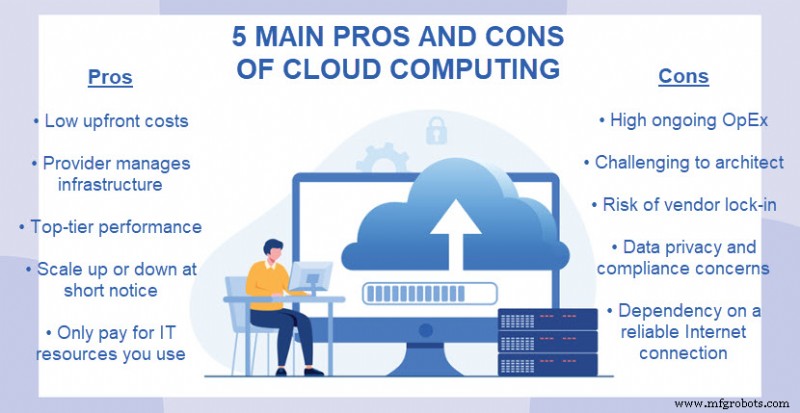
云的好处
以下是云计算的主要优势:
- 无前期投资: 使用云意味着您不必购买托管设备并设置足够的现场设施。您也不必支付公用事业(例如电力)的费用或雇用一支熟练的 IT 管理员团队。
- 停机风险更低: Cloud providers have uptime standards that are impossible to ensure on an in-house level.
- Data accessibility: The cloud enables employees to access resources and data from any location or device. This feature makes the cloud a natural fit with remote-first teams and companies with BYOD policies.
- Easy to scale: A business using the cloud is able to scale its IT resources up or down based on current demands.
- No overhead: The team can monitor the use of cloud resources to ensure there's no unnecessary spending.
- Easier (and more reliable) backups: Once the data resides in the cloud, all backup and disaster recovery (BDR) goals are easier to achieve.
- Improved team collaboration: The cloud allows employees to share files quickly and easily. There's less need for USBs, massive downloads, and email attachments, so you also lower the attack surface.
- Top-tier performance: Cloud services run on the latest computing hardware, so expect high performance for your cloud-based app.
- Global scalability: If you are expanding into a new market or a user base at a specific location is growing, you deploy new servers to that area and meet current demands instantly.
- Unlimited storage: A cloud never runs out of storage room.
- Data security: Cloud providers offer many advanced features to ensure high data security. These measures are not a realistic in-house option for most companies.
Disadvantages of the Cloud
Here are the main downsides of using cloud computing:
- You never own the equipment: While setting up in the cloud is cheaper than building an in-house server room, expenses pile up over time. In a few years, you might look back and realize all that DCO money could have gone towards a private hosting facility.
- Clouds are complex: Private clouds, multi-cloud, and hybrid architectures are hard to design, set up, protect, and manage. Ensure the in-house team has sufficient skill sets before you go all-in on an ambitious cloud project.
- No internet, no access: Only needing an Internet connection to access data is both a benefit and a concern. If you're offline, there's no way to access the cloud until you're back online.
- 供应商锁定: If you set up workloads at a third-party provider, you will likely experience vendor lock-in over time. This problem prevents moving to another vendor without impacting the hosted app. Common issues include prolonged downtime, software incompatibilities, and pricy cloud migrations.
- Limited control: The provider is the one who owns and manages the cloud. Stay clear if this hands-off approach does not work for you (or set up a private cloud in your office).
- Compliance issues: It is sometimes challenging to meet industry-specific regulations when hosting data at a third-party facility.
- Security and risk concerns: While providers invest heavily in keeping data safe, cloud computing requires you to share data with a third party. You do not have direct control or complete visibility over data storage, which introduces new risks.
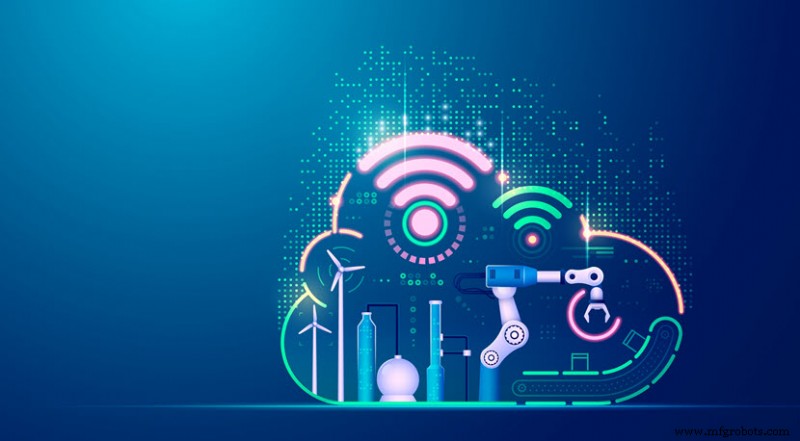
Cloud Computing Applications
The cloud can serve any IT role, but some use cases make more sense than others. Here are the most common cloud computing applications:
- Online storage platforms that enable users to upload, view, and share files. These systems are either open to the public or reserved for corporate use.
- Online meeting apps for smooth video conferencing and screen sharing for employees spread across the world.
- E-commerce websites that have sudden spikes in usage (e.g., such as an online shop that does more business during the holiday season).
- Entertainment apps that use a multi-cloud strategy to interact with a geographically spread-out audience (a website for online gaming or a streaming service).
- Deploying ready-made software testing and development environments (particularly valuable in a CI/CD and DevOps context).
- Cloud-native apps that run on microservices and containers (such as software running on Docker Swarm or Kubernetes).
- Social media apps that enable a large number of users to connect and share videos, images, stories, etc.
- Virtual Desktops (VDI) a company deploys to employees.
- Apps that offer various cloud-based art services (e.g., instant designing, editing images, printing, etc.).
- Anti-virus apps that analyze data in the cloud to find and remove malware and other cyber threats.
- GPS systems that require near or real-time responsiveness.
- Accounting software that tracks expenses, profits, and losses in real-time.
- Email apps that ensure smooth communication regardless of where senders and recipients reside.
- E-learning platforms, online distance learning programs, and student info portals.
- Various healthcare use cases (storing and sharing patient data, booking appointments, sending email reminders, performing medical data analysis, etc.).
- Postal service software that tracks global shipments.
- Cloud-based data backups and disaster recovery.
- Machine learning and AI use cases that require rapid data analysis (such as AI-powered big data analytics).
Most Famous Cloud Computing Examples
Here are a few of the most popular and widely used services that rely on cloud computing:
- Google Drive and Microsoft 365 use the cloud to enable users to access docs, media files, presentations, and spreadsheets from anywhere and on any device.
- Apple iCloud enables cloud-based online storage and backup of emails, contacts, calendars, and more. The app also provides file syncing between Macs and iOS devices.
- Zoom is a cloud-based platform for video and audio conferencing. The app records meetings and saves them to the cloud, enabling the user to access them anywhere and at any time. Microsoft Teams and GoToMeeting also rely on cloud computing.
- Dropbox is a simple file-sync and storage service that relies entirely on the cloud.
- Slack is a cloud-based messaging platform that connects every employee in the same workplace.
- Sophos Endpoint Protection and Kaspersky Endpoint Security Cloud are two of the most popular cloud-based anti-virus programs.
- Skype and WhatsApp take advantage of the cloud's ability to provide users with remote access to data.
- Salesforce is a cloud-based CRM tool that helps a business manage customer relations and generate more sales leads.
- Netflix uses AWS to provide billions of hours of service to customers around the globe.
- AWS Lambda enables developers to run code for apps or back-end services without having to provision or manage servers. Google Cloud Functions and Azure Functions offer similar serverless services.
- Chromebooks are cloud-centric devices with just enough local storage and power to run Chrome OS. Everything you store on a Chromebook goes to the cloud.
Cloud Computing Statistics You Should Know
Here are a few stats that are worth knowing about the current cloud computing market:
- Over 74% of tech companies claim that cloud computing is making a measurable impact on their business.
- SMBs report that using cloud computing is 40% more cost-effective than an equivalent in-house system.
- Almost 82% of companies that use the cloud report increased efficiency and team productivity.
- An average enterprise relies on about 1,400 cloud-based apps. An average employee uses 36 cloud-based services in a work week.
- More than 90% of businesses report a boost in security and easier compliance after adopting the cloud.
- Cloud data centers processed 94% of all workloads at the end of 2021.
- AWS currently holds 31% of the cloud market, followed by Microsoft Azure (20%) and Google Cloud (7%).
- Google Drive is the world's most used cloud storage service, with 94.44% of Internet users relying on the service. Dropbox is in second place with 62.2% and OneDrive in third with 39.35%.
- Almost 92% of organizations that use the cloud have a multi-cloud strategy.
- About 1/3 of an average company's IT expenses go towards cloud computing services.
- Three of the most prevalent issues surrounding the use of the cloud are security (83%), managing cloud computing spending (82%), and governance (79%).
- Business owners claim around 30% of their cloud budget goes to waste, which explains the recent interest in cloud cost management tools.
- The three main goals of companies looking to advance their cloud use are migrating more workloads (70%), optimizing current cloud costs (59%), and pursuing a cloud-first strategy (50%).
- Human error is the cause of 88% of security failures in the cloud.
The Future of Cloud Computing
Cloud computing is an ever-evolving industry that's prone to change. Here's a quick overview of what to expect in the coming years:
- The value of the cloud computing market will reach $623.3 billion by the end of 2022 . By 2025, this figure will pass $832 billion (that year, cloud will store over 100 zettabytes of data).
- By 2025, experts predict businesses will deploy 95% of all new workloads on cloud-native platforms.
- Providers will continue competing for market share, so expect public cloud offerings to evolve. Research suggests that entry-level IaaS will see the most significant changes as vendors look to offer more than ordinary compute and storage instances.
- Companies will start to place more trust in cloud computing services. Right now, around 48% of businesses are comfortable with storing classified data on the cloud (both regular and encrypted data). This figure will continue to rise in the coming years.
- Serverless computing will continue to grow in popularity as companies realize the value of entirely freeing teams from infrastructure management.
- More companies will start to use the public cloud for big data processing. Providers are already responding with solutions for handling massive data sets (e.g., Google BigQuery and Microsoft Azure Data Lake).
- SaaS will see the most significant rise out of all cloud service types in the coming years. Expect to see the market for SaaS products get close to $200 billion by 2024.
- Companies will increasingly turn towards cloud-based AI and machine learning services. SMBs will benefit the most from ready-to-use advanced services as they cannot create such software in-house.
- Edge computing will continue to grow as a go-to solution for cloud-based apps that must process data in real-time.
The Cloud is Not Going Away Any Time Soon
Is cloud computing perfect? Certainly not, but its benefits far outweigh the drawbacks, so expect the cloud to continue to play a crucial part in IT going forward. The technology opens many doors that would otherwise remain shut for teams lacking sufficient IT skills. Add the cloud's ability to lower IT costs to the equation, and it becomes clear why this tech is not going away anytime in the foreseeable future.
云计算


